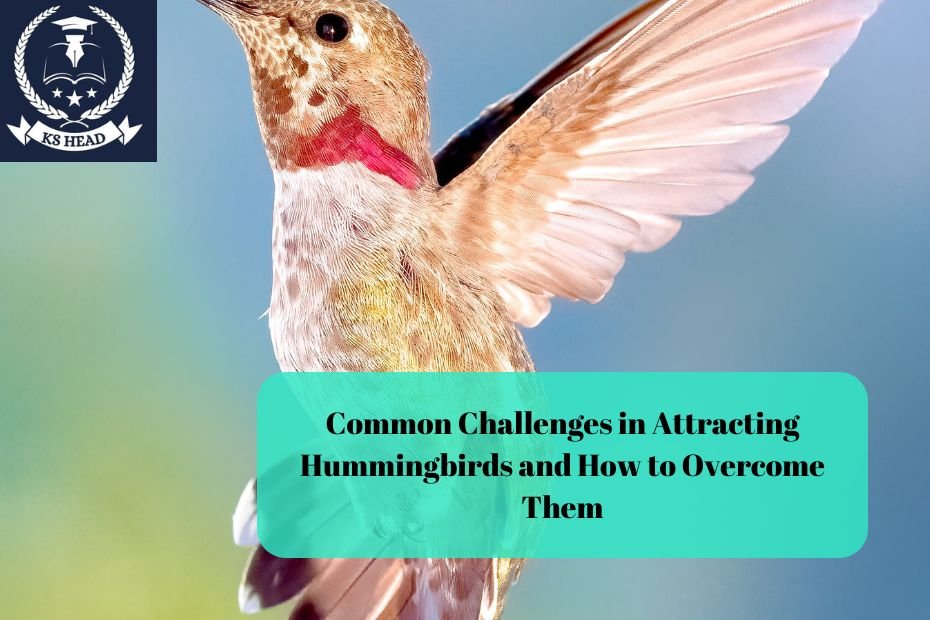Attracting hummingbirds to your garden or backyard can be an incredibly rewarding experience. These tiny, vibrant birds bring life, beauty, and a sense of wonder to any outdoor space. However, many bird enthusiasts encounter challenges when trying to invite hummingbirds into their yards. In this article, we’ll explore common challenges in attracting hummingbirds and offer practical solutions to overcome them.
1. Inappropriate Feeder Placement
One of the most common challenges in attracting hummingbirds is improper feeder placement. Hummingbirds are extremely active and curious, but they also value safety and comfort. Placing your feeder in an unsuitable location can result in fewer visits from these delightful creatures.
Solution:
To attract hummingbirds effectively, place the feeder in a quiet and shaded area of your garden. Hummingbirds are drawn to locations where they can easily escape predators, so avoid putting the feeder in areas that are too exposed, such as open yards or near busy streets. Choose a spot with nearby perches like tree branches or bushes, where hummingbirds can rest between feedings.
Additionally, positioning the feeder near flowers that naturally attract hummingbirds can increase your chances of success. Bright, tubular flowers like trumpet vine or bee balm can entice them to investigate your feeder.
2. Using the Wrong Type of Feeder
Another frequent issue is using the wrong type of hummingbird feeder. Feeders that leak or are difficult to clean can deter hummingbirds, as well as attract unwanted insects like ants or bees.
Solution:
Choose a feeder that is easy to maintain, with simple components that can be disassembled for thorough cleaning. Look for feeders with built-in ant moats to keep insects away from the nectar. A red-colored feeder is preferable, as hummingbirds are especially attracted to this color.
Make sure the feeder has several ports to accommodate multiple birds at once. Additionally, check that the feeder does not have sharp edges or parts that could harm the birds’ delicate beaks.
3. Poor Nectar Quality or Inappropriate Nectar Mix
Hummingbirds have a high metabolism and rely on nectar for energy. A common mistake is using store-bought nectar that contains artificial dyes or ingredients that are not suitable for hummingbirds. Some people may also use honey or other sweeteners that can harm the birds.
Solution:
It’s best to create your own nectar using a simple recipe: four parts water to one part white granulated sugar. Boil the water, dissolve the sugar, and let it cool before filling your feeder. This mixture closely mimics the natural nectar that hummingbirds find in flowers.
Avoid using honey, artificial sweeteners, or red food dye, as these can be harmful to the birds. Regularly change the nectar every 3-5 days, or more frequently in hot weather, to prevent fermentation or mold growth, which can harm the birds.
4. Competition from Other Wildlife
Attracting hummingbirds can sometimes mean dealing with competition from other animals. Bees, ants, wasps, and larger birds like orioles may invade your feeder, making it difficult for hummingbirds to feed comfortably.
Solution:
To deter insects like bees and ants, invest in a feeder with bee guards and an ant moat. An ant moat is a small water-filled reservoir that surrounds the hanger of the feeder, preventing ants from crawling down to the nectar. Bee guards are small mesh covers over the feeder’s ports that prevent bees from accessing the nectar while still allowing hummingbirds to feed.
For larger birds like orioles, consider placing separate feeders at different heights or using a hummingbird-specific feeder with smaller ports that larger birds cannot use.
5. Lack of Flowers or Natural Habitat
While feeders are an excellent way to attract hummingbirds, they are not enough on their own. Hummingbirds are naturally drawn to gardens with a variety of flowering plants that offer nectar. Without flowers or natural vegetation, your yard may not provide a welcoming environment for these birds.
Solution:
Plant native flowers that are known to attract hummingbirds. Opt for bright-colored flowers with tubular shapes, such as coral bells, trumpet creeper, or salvia. These flowers have nectar-rich blooms that hummingbirds find irresistible. Group your plants in clusters, as this will create a visual target for the birds and make your garden more appealing.
Additionally, ensure that your garden offers shelter and perching spots. Small trees, shrubs, and vines provide cover from predators and give hummingbirds a place to rest between feedings.
6. Insufficient Water Sources
Hummingbirds not only rely on nectar but also need water for bathing and hydration. A lack of accessible water sources in your yard can reduce your chances of attracting hummingbirds.
Solution:
Provide shallow, clean water sources like birdbaths or misters that hummingbirds can use for drinking and bathing. Hummingbirds enjoy the gentle misting from sprinklers or special bird misters. Birdbaths should be shallow and placed near your flowers and feeders, but make sure to change the water regularly to prevent stagnation.
7. Irregular Feeder Maintenance
A dirty or poorly maintained feeder can become a major deterrent to hummingbirds. Moldy nectar or clogged feeding ports will drive the birds away, as they are sensitive to unclean feeding environments.
Solution:
Clean your feeder at least once a week, or more frequently in hot weather. Use warm water and mild dish soap, and scrub the feeding ports to remove any mold or sugar buildup. Make sure the feeder is thoroughly rinsed before refilling it with fresh nectar.
If you notice black mold spots inside the feeder, use a solution of one part vinegar to four parts water to clean it. Regular maintenance ensures that your feeder remains inviting and safe for the birds.
8. Seasonal Changes
In some regions, seasonal changes can affect the hummingbird population. Hummingbirds migrate during the colder months, which can lead some people to mistakenly believe they are doing something wrong when the birds disappear.
Solution:
If you live in a region with seasonal migration, don’t be discouraged if hummingbirds stop visiting your feeder during certain times of the year. You can continue to maintain your feeders, as some species of hummingbirds may still visit during migration. As the weather warms up, you’ll likely see more regular visits as hummingbirds return to your area.
In regions where hummingbirds are present year-round, keep your feeders filled and monitor for any changes in activity based on the seasons.
9. Predators in the Area
Another challenge can be the presence of predators, such as cats or larger birds like hawks, which can deter hummingbirds from visiting your garden.
Solution:
If you have outdoor cats, try to keep them indoors when you expect hummingbirds to visit. Avoid placing feeders near bushes or low branches where predators can hide. By positioning the feeder in an open area with nearby perches, you create a safer environment for the hummingbirds to feed.
For larger predators, you may need to invest in bird-safe netting around your feeding area or adjust the feeder’s location to make it less accessible to potential threats.
10. Not Enough Time
Patience is key when attracting hummingbirds. Sometimes, even when all the right elements are in place, it can take time for the birds to discover your feeder.
Solution:
Be patient and give the hummingbirds time to locate your feeder. If you’ve planted flowers, provided water, and maintained your feeder, they are likely to find their way to your garden. You can also try placing bright red ribbons or other decorations near the feeder to catch their attention.
Keep monitoring the activity, and eventually, you’ll see an increase in hummingbird visitors.
Conclusion
Attracting hummingbirds to your garden or backyard can be challenging, but with the right strategies, you can create an inviting environment for these fascinating birds. By addressing issues such as feeder placement, nectar quality, competition from other animals, and regular maintenance, you can enjoy watching hummingbirds feed and thrive in your outdoor space. Be patient, stay consistent, and soon enough, your garden will become a hummingbird haven.
FAQs
1. How often should I change the nectar in my hummingbird feeder?
Nectar should be changed every 3-5 days, or more frequently in hot weather to prevent fermentation or mold growth.
2. What flowers are best for attracting hummingbirds?
Hummingbirds are attracted to bright, tubular flowers such as trumpet vine, bee balm, salvia, and coral bells.
3. Why aren’t hummingbirds visiting my feeder?
This could be due to improper feeder placement, poor nectar quality, or competition from other wildlife. Ensure your feeder is clean and in a safe, shaded area.
4. How do I keep ants and bees away from my hummingbird feeder?
Use a feeder with ant moats and bee guards to keep insects from reaching the nectar while still allowing hummingbirds to feed.
5. Can I attract hummingbirds year-round?
In regions where hummingbirds migrate, they may not visit during certain seasons. However, in warmer climates, you may see them year-round by maintaining feeders and flowers.

